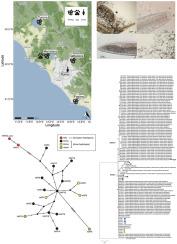Thelaziosis in central Italy: Molecular detection of a variant haplotype in a human case and epidemiological aspects
IF 1.7
Q3 PARASITOLOGY
Current research in parasitology & vector-borne diseases
Pub Date : 2025-01-01
DOI:10.1016/j.crpvbd.2025.100316
引用次数: 0
Abstract
Thelazia callipaeda is an emerging zoonotic nematode responsible for ocular infection in Europe, transmitted by lachryphagous drosophilid flies of the genus Phortica. In this study, we updated the epidemiological picture of thelaziosis in Italy analysing parasites collected from a human case, in the vector Phortica variegata, and in a single naturally infected definitive host (dog), all from the same geographical area, the Latium region, central Italy. Median joining network and phylogenetic analyses based on the mitochondrial cytochrome c oxidase subunit 1 (cox1) gene of T. callipaeda revealed a novel variant haplotype, named Haplotype 22, for the nematode from the human patient, distinct from the common Haplotype 1, detected for the nematodes from the infected dog and the positive specimens of P. variegata flies. The discovery of the new circulating haplotype variant, besides the dominant Haplotype 1, the so far only known haplotype in Europe, expands the knowledge on the genetic polymorphism of T. callipaeda. The results obtained support the hypothesis that the European population of T. callipaeda, despite its lower level of polymorphism, is genetically differentiated from that occurring in Asia, as previously suggested. These findings highlight the importance of the parasite’s monitoring in Europe, after its first detection in the late 1990s, possibly adopting a One Health approach. The zoonotic role of T. callipaeda, transmitted by Phortica spp. in urban settings of Italy as here demonstrated, evidences the need for increasing medical awareness.

意大利中部的血吸虫病:一例人类病例变异单倍型的分子检测和流行病学方面
callipaeda是一种新兴的人畜共患线虫,在欧洲引起眼部感染,由Phortica属的嗜泪果蝇传播。在这项研究中,我们更新了意大利血吸虫病的流行病学情况,分析了从意大利中部拉提姆地区同一地理区域收集的一例人类病例、病媒斑纹虫和单一自然感染的最终宿主(狗)身上收集的寄生虫。基于callipaeda线粒体细胞色素c氧化酶亚基1 (cox1)基因的中位连接网络和系统发育分析显示,来自人类患者的线虫具有一种新的变异单倍型,命名为haplotype 22,不同于来自感染狗的线虫和阳性变种蝇标本中检测到的常见单倍型1。除了欧洲已知的优势单倍型1外,新的循环单倍型变异的发现扩大了对T. callipaeda遗传多态性的认识。这些结果支持了一种假设,即尽管欧洲的T. callipaeda种群的多态性水平较低,但与亚洲的T. callipaeda种群在遗传上是不同的,正如之前提出的那样。这些发现强调了在20世纪90年代末首次发现这种寄生虫后,在欧洲监测这种寄生虫的重要性,可能采用“同一个健康”方法。如本文所展示的,意大利城市环境中由Phortica spp传播的T. callipaeda的人畜共患作用证明需要提高医疗意识。
本文章由计算机程序翻译,如有差异,请以英文原文为准。
求助全文
约1分钟内获得全文
求助全文

 求助内容:
求助内容: 应助结果提醒方式:
应助结果提醒方式:


